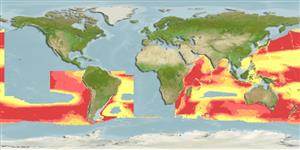>
Lophiiformes (Anglerfishes) >
Himantolophidae (Footballfishes)
Etymology: Himantolophus: Greek, himas or himantos = leather strap, thong or leash (referring to the thick leathery illicium) + Greek, lopho or lophio = crest or tuft (referring to the baited illicium projecting from the head) (Ref. 86949).
Environment: milieu / climate zone / depth range / distribution range
Écologie
marin bathypélagique; profondeur 338 - 1360 m (Ref. 86949). Deep-water
Circumglobal in the southern hemisphere except eastern Pacific (Ref. 7300). Range extended to the Falkland Is. (Ref. 80772) and probably a first record in the Philippines (Ref. 95664).
Taille / Poids / Âge
Maturity: Lm ? range ? - ? cm
Max length : 40.0 cm TL mâle / non sexé; (Ref. 33839)
Description synthétique
Clés d'identification | Morphologie | Morphométrie
Rayons mous dorsaux (Total) : 5; Rayons mous anaux: 4. This species is distinguished in having the illicium with a bulbous distal light organ, originating from behind the tip of the snout; external second cephalic ray absent; esca without bony denticles; posterior appendage present, bifurcated at the base and each primary branch had a side branch near the base; distal appendage absent (Ref. 80772). Metamorphosed females characterized further by having a series of 2-7 filaments emerging from the anterior margin of the 2 primary branches of paired posterior escal appendage; posterolateral appendages simple or bifurcated at tip, longest is less than 10% SL in specimens less than 10 cm; presence of small dermal spinules on stem of illicium, escal bulb and escal appendages in specimens greater than 3 cm; low and indistinct papillae of snout and chin; skin devoid of white patches; caudal fin rays white or faintly pigmented in specimens less than 10 cm. Adult males with 11-13 olfactory lamellae; diameter of posterior nostril 5.7-6.7% SL, length of snout 17-18% SL; presence of about 20-25 upper denticular teeth and 22-32 lower denticular teeth (Ref. 86949).
Mesopelagic species (Ref. 7300).
Life cycle and mating behavior
Maturities | Reproduction | Spawnings | Egg(s) | Fecundities | Larves
Paxton, J.R., D.F. Hoese, G.R. Allen and J.E. Hanley, 1989. Pisces. Petromyzontidae to Carangidae. Zoological Catalogue of Australia, Vol. 7. Australian Government Publishing Service, Canberra, 665 p. (Ref. 7300)
Statut dans la liste rouge de l'IUCN (Ref. 130435)
Menace pour l'homme
Harmless
Utilisations par l'homme
Outils
Articles particuliers
Télécharger en XML
Sources Internet
Estimates based on models
Preferred temperature (Ref.
123201): 2.3 - 10, mean 7.1 °C (based on 612 cells).
Phylogenetic diversity index (Ref.
82804): PD
50 = 0.5000 [Uniqueness, from 0.5 = low to 2.0 = high].
Bayesian length-weight: a=0.01995 (0.00906 - 0.04395), b=3.01 (2.83 - 3.19), in cm total length, based on all LWR estimates for this body shape (Ref.
93245).
Niveau trophique (Ref.
69278): 4.0 ±0.70 se; based on food items.
Fishing Vulnerability (Ref.
59153): Low to moderate vulnerability (30 of 100).
